5-Year Report Card: Modi’s Next Big Challenge Is Agriculture
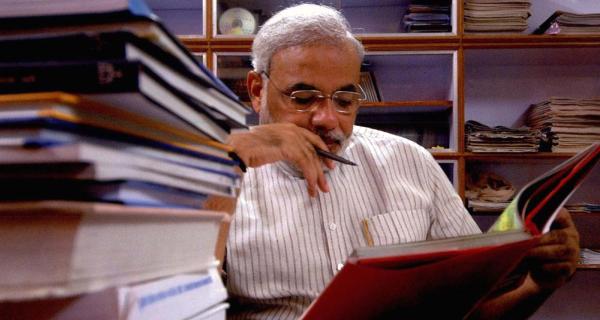
| Highlights * Gujarat’s economic recovery since global recession remarkable * Agriculture needs boost since 52% people are still dependent on farming * Hiring pace slows down in industries but productivity increasing |
Chief Minister of Gujarat Narendra Modi will face the electorate again in December 2012. So, it’s time to look at his achievements over the past 5 years, and try to understand whether he did better in this stint or his last stint as the Chief Minister. IndiaSpend looks at some key economic indicators in this article, and will look at key social indicators in a forthcoming article.
First, a look at the growth numbers of GSDP and per-capita NSDP since 2007.
Table 1: Growth of GSDP and per-capita NSDP since 2007
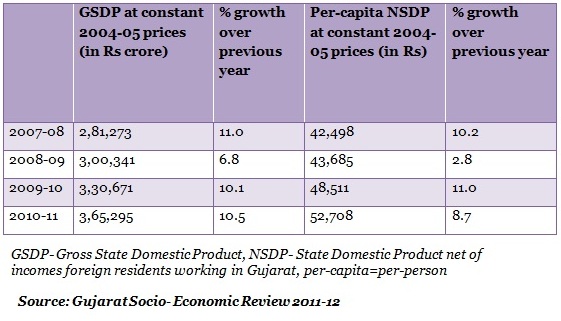
From (Table 1) we can see that Gujarat was able to maintain double-digit growth rates in all years except when the global recession hit its economy in 2008-09 and growth slipped to 6.8%. Per-person income has also been increasing, and touched Rs 52,708 in 2010-11. The per-capita growth rates are also around 10% except in the year 2008-09 when it was around 3%.
Thus, if judged on a basic level, the performance of Gujarat has been commendable over the period. However, as we argued in a previous article, the performance, relative to some other states like Tamil Nadu and Maharashtra, could have been better.
To analyse the Modi government’s performance, we will now compare the two periods, 2002-07 and 2007-11.
Average Growth Rate of GSDP and NSDP per-capita over 2002-07 and 2007-11
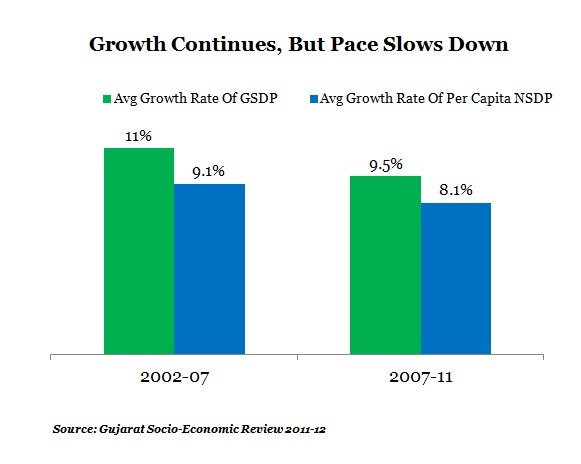
As can be seen from the graph, the growth rates of both GSDP and per-capita incomes were better in the period 2002-07 than in 2007-11. In 2002-07, GSDP grew at an average of 11%, which dropped to 9.5% for the period 2007-11. As far as per-capita NSDP is concerned, the rate of growth was 9.1% for the period 2002-07 and 8.1% for the period 2007-11. So, the performance of the economy and its effect on the people has been weak for the latter period.
But if we take the global conditions into account, the performance is not bad at all. If we leave the year 2008-09 out of our calculations, the average growth rate of GSDP over 2007-11, was 10.5% - only a slight decline from 2002-07. Similarly, the average growth rate of per-capita income would be 9.9% - a significant improvement over the period 2002-07.
Thus, barring the effects of the global recession, the performance of the Modi government has been roughly similar for the two periods if not better when it comes to overall growth numbers.
Analysing Agriculture/Industrial Growth
Let’s now look at a few indicators relating to agriculture and industrial growth.
In the first decade of the 21st century, agriculture has grown at an average of 10.7% in Gujarat. If we look at food grain production, it went up from 44 lakh tonne in 2002-03 to 100.7 tonne in 2010-11. Cotton production went up from 18.8 lakh bales to 98.2 lakh bales over the same period. Oilseed production went up from 18.7 lakh tonne to 51.4 lakh tonne. Let’s look at the yearly growth rates.
Table 2 – Agricultural Growth Rates in 3 Categories
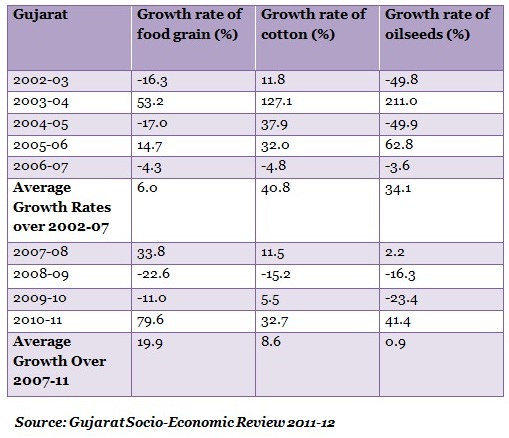
A look at (Table 2) suggests that, on average, the period 2002-07 was better than 2007-11 when it comes to average growth in non-food grain crops. The average growth rate of cotton was 41% over 2002-07 but slipped to 8.6% over 2007-11. The corresponding figure for oilseeds was 34.1% and 0.9%, respectively. For food grain, the latter period was better. The average growth rate of food grain improved from 6% over 2002-07 to 19.9% over 2007-11.
But what is obvious from the table is that average growth rates do not make much sense in this context. The variation in growth rate in the categories across years is huge. This suggests primary dependence of Gujarat’s agriculture on monsoons. Given the fact that 52% of the population of Gujarat draws its livelihood from agriculture, stability in that sector is a necessity. It seems that in his drive to industrialise the state, Narendra Modi may have ended up neglecting the needs of the agricultural sector.
Let us now look at the performance of the industrial sector. Over 2000-04, the average industrial growth rate was around 3.9%. It improved to 12.6% for the period 2004-09.... a significant improvement.
To understand the industrial improvement better, we will look at the increase in the number of factories and employment in factories over the period 2002-10.
Table 3: Number of Factories and Employment
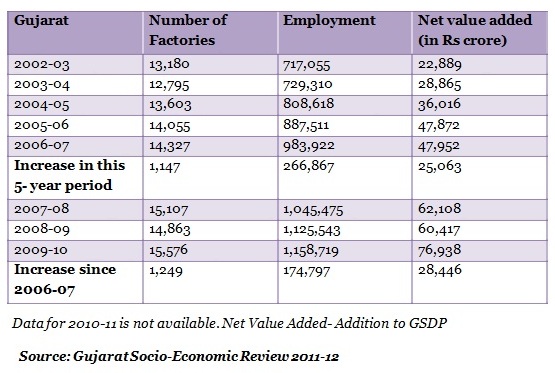
As can be seen from (Table 3), since 2002-03, the number of operating factories has gone up by 2,396. Employment has gone up from 0.71 million people to 1.15 million people. Thus, new employment has been provided to 0.44 million people. Addition to GSDP has been to the tune of Rs 54,000 crore.
If we compare the two periods 2002-07 and 2007-10, the increase of factories were more over the latter period. Over the first period, 1,147 factories were added providing new employment to 2.6 lakh people. On an average, every year, 53,373 new people were provided employment. Since 2006-07, 1,249 new factories became operational. The increase in employment was to the tune of 1.7 lakh or average annual employment increase of 43,699 people.
Even though lesser number of people got employment in factories since 2006-07, productivity seems to have increased in this period. Over 2002-07, the addition to GSDP from these factories was to the tune of Rs. 25,063 crore or Rs 5,012 crore, on average, every year. That increased to Rs 28,446 crore or Rs 7,111 crore, on average, every year since 2006-07.
Agriculture Still A Big Challenge
Even though the Modi government has performed well when it comes to overall growth and industrialisation, it needs to take serious measures to curb fluctuations in the agricultural sector if it wins the elections. And the hard truth is that despite being one of the most industrialised states in the country, most of its people still survive on agriculture. While economic growth can lead to improvements in social conditions, a future IndiaSpend article will look to see what the Modi government has achieved in education, health and poverty.


